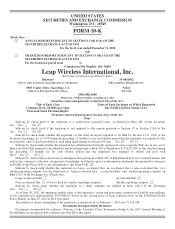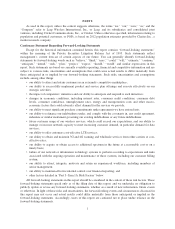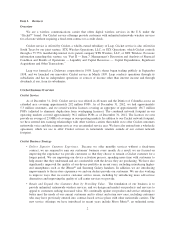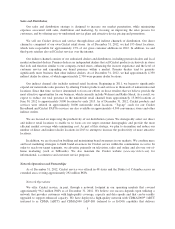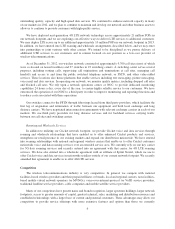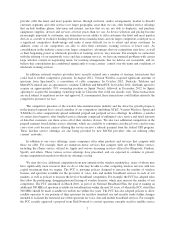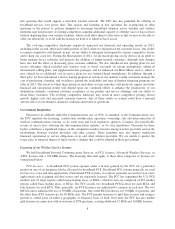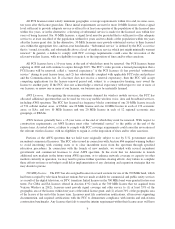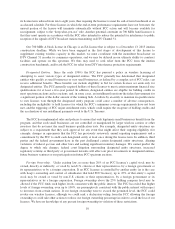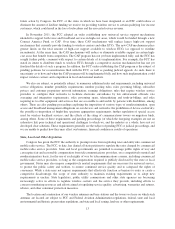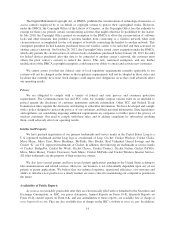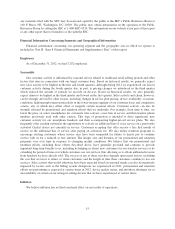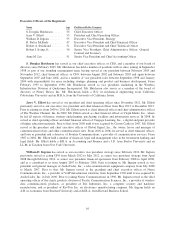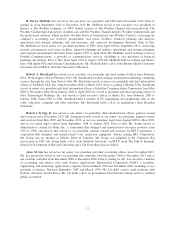Cricket Wireless 2012 Annual Report Download - page 21
Download and view the complete annual report
Please find page 21 of the 2012 Cricket Wireless annual report below. You can navigate through the pages in the report by either clicking on the pages listed below, or by using the keyword search tool below to find specific information within the annual report.provide; offer the latest and most popular devices through exclusive vendor arrangements; market to broader
customer segments and offer service over larger geographic areas than we can; offer bundled service offerings
that include landline phone, television and internet services that we are not able to duplicate; and purchase
equipment, supplies, devices and services at lower prices than we can. As device selection and pricing become
increasingly important to customers, any restriction on our ability to offer customers the latest and most popular
devices as a result of exclusive dealings between device manufacturers and our larger competitors could put us at
a significant competitive disadvantage and make it more difficult for us to attract and retain customers. In
addition, some of our competitors are able to offer their customers roaming services at lower rates. As
consolidation in the industry creates even larger competitors, advantages that our competitors may have, as well
as their bargaining power as wholesale providers of roaming services, may increase. For example, in connection
with the offering of our nationwide voice and data roaming services, we have encountered problems with certain
large wireless carriers in negotiating terms for roaming arrangements that we believe are reasonable, and we
believe that consolidation has contributed significantly to some carriers’ control over the terms and conditions of
wholesale roaming services.
In addition, national wireless providers have recently entered into a number of strategic transactions that
could lead to further competitive pressures. In August 2012, Verizon Wireless acquired significant amounts of
spectrum from SpectrumCo, a consortium of cable companies. In October 2012, Deutsche Telekom and
MetroPCS entered into an agreement to combine T-Mobile and MetroPCS. In October 2012, Softbank agreed to
acquire an approximately 70% ownership position in Sprint Nextel, followed in December 2012 by Sprint
agreeing to acquire the remaining ownership stake in Clearwire that it did not already own. These transactions
are each subject to regulatory review and approval. If consummated, these transactions could further intensify the
competitive pressures we face.
The competitive pressures of the wireless telecommunications industry and the attractive growth prospects
in the prepaid segment have caused a number of our competitors (including AT&T, Verizon Wireless, Sprint and
T-Mobile) to offer competitively-priced unlimited prepaid and postpaid service offerings. In addition, a number
of carriers have begun to offer bundled service offerings comprised of unlimited voice service and fixed amounts
of data that customers can share across all of their wireless devices. We also face additional competition in the
prepaid segment from Lifeline service offerings, which are available to consumers at reduced costs (and in some
cases at no cost) because carriers offering this service receive a subsidy payment from the federal USF program.
These Lifeline service offerings are also being provided by new MVNO providers who are utilizing other
carriers’ networks.
In addition to our voice offerings, many companies offer other products and services that compete with
those we offer. For example, there are numerous music services that compete with our Muve Music service,
including the iTunes service offered by Apple and various streaming services offered by Rhapsody, Pandora,
Spotify and others. These various service offerings have presented, and are expected to continue to present,
strong competition in markets in which our offerings overlap.
We may also face additional competition from new entrants in the wireless marketplace, many of whom may
have significantly more resources than we do or who may be able to offer competing wireless services with less
capital investment than we require. The FCC is pursuing policies designed to increase the number of wireless
licenses and spectrum available for the provision of voice, data and mobile broadband services in each of our
markets, as well as policies to increase the level of broadband competition. For example, the FCC has adopted rules
that allow the partitioning, disaggregation and leasing of wireless licenses, which may increase the number of our
competitors. The FCC announced in March 2010, as part of its National Broadband Plan, the goal of making an
additional 500 MHz of spectrum available for broadband use within the next 10 years, of which the FCC stated that
300 MHz should be made available for mobile use within five years. The FCC has also adopted policies to allow
satellite operators to use portions of their spectrum for ancillary terrestrial use and recently made further changes
intended to facilitate the terrestrial use of this spectrum for voice, data and mobile broadband services. For example,
the FCC recently approved a proposal from Dish Network to convert spectrum currently used for satellite service
7


